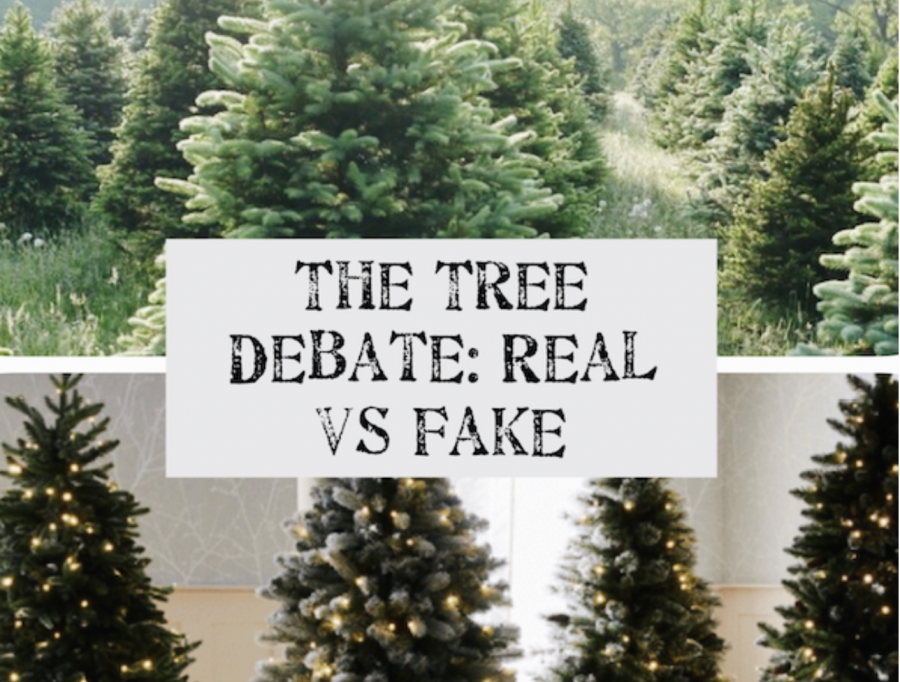Let’s Get Real: Invest in the more sustainable Christmas tree
December 10, 2021
Every year, it is impossible to avoid the ongoing Christmas tree debate: Should you get a fake tree or a real tree?
From aesthetic, to allergies, to durability, there are a multitude of arguments for both sides. However, the most important factor to consider is the impact that they have on the environment.
Which is more sustainable?
Many may argue that investing in a plastic tree is more environmentally-friendly than buying a real tree. That way you don’t have to cut down a new tree every year, right?
Not necessarily.
Yes, plastic trees can be used for many years in a row. Despite this, the average family only keeps their fake tree for six to nine years. These trees can rarely be recycled. Plastic cannot biodegrade, and most fake Christmas trees are made up of composite materials (a combination of two materials with different physical and chemical properties) to improve stiffness and strength, making it very difficult to be recycled at the end of its use.
Additionally, a single average-height (six foot) plastic tree has a carbon footprint equivalent to 40 kilograms of greenhouse gas emissions when produced. That is more than twice that from a real tree left in a landfill and about ten times more than a real tree that is burnt.
The short term nature of fake trees is minimal compared to the long-term environmental burden posed from the plastic rotting in landfills for indefinite amounts of time.
But wait… Is there an even better option if you prefer non-living trees? Yes! Trees constructed from materials like bamboo or acacia are the best option if you’d prefer a tree-looking tree. These materials are very fast growing, making them incredibly renewable, easily compostable, and long-lasting; these trees could last you decades.
Well then, what about real trees?
Yes, cutting down Christmas trees is a form of deforestation. Cutting down a tree ceases its carbon absorption, inevitably letting out a portion of that carbon as it is chopped down.
Nevertheless, the average tree absorbs about 21 kilograms per year; Christmas trees take around six to eight years to grow, so the amount of carbon taken in by the trees during their life-span exceeds the amount lost if burnt or decomposing in a landfill.
The true benefits of real trees can also be undermined if not grown and cared for in a sustainable manner. However, as long as the trees are farmed to their fully-grown or almost fully-grown potential, they are able to absorb the maximum amount of carbon dioxide and emit fresh oxygen.
Trees can be re-planted to mitigate the effects of the previous one being cut down.
Many tree farmers follow stump culture, which is the practice of cutting a tree while leaving part of the stump and lower branches, allowing it to regenerate new sprouts and grow into a new tree that is able to be harvested. Or, most Christmas tree farmers plant one to three new seedlings for every tree cut down, making the positive environmental impact greater than the negative one.
Real trees are also biodegradable, so they can be reused and recycled in a variety of ways instead of being thrown in landfills.
To truly mitigate the effects of climate change, buy your living tree from a local farm. This way, your carbon footprint due to driving will be reduced.
Then what should you do once you’re done with your tree?
If you have a fake tree and it has come to the end of its life, there are not many environmentally-friendly options; if you’re feeling creative, it is possible to transform it into other decor such as wreaths, garlands, or other arrangements.
On the contrary, if you have a real tree and want to get rid of it after the end of the holiday season, there are several options.
Often, people just leave them out on the curb to get picked up. If you live in Lake Forest, you may leave it outside on any regularly scheduled household recycling days during the month of January, where it will in most cases be chopped up and recycled into mulch.The process is the same for those who live in Lake Bluff, except pickup is available through the second week of January.
However, if you want to be completely sure of the outcome of your tree, Lake County Forest Preserves accepts drop-offs to each of these sites from Dec 26 to Feb 1: Grant Woods, Greenbelt, Half Day, Heron Creek, Lakewood, Old School, Ryerson Woods, and Van Patten woods. At any of those locations, your tree will be chipped and used to improve trails and landscaping.
Real trees are also useful for your own green space at home. You can break off the needles and cut the branches into small pieces and use it as mulch or use its entire limbs to cover garden beds. This reduces frost heaving by insulating potentially sensitive plants.
If you’re feeling crafty and adventurous, you can pluck off the needles and use them as air freshener or transform the branches into some sort of product of woodworking.
Our Earth is grappling with the results of human ignorance and we need to act quickly. So if you want to get real, real is the perfect place to start.








Environmentally-mind staff member • Dec 10, 2021 at 1:55 pm
There is a third option, which I adopted 2 years ago. I bought a potted blue spruce, I kept it outside till just before Christmas and we started a new tradition of decorating the tree close to Christmas and taking down the decorations soon after. Prior to Christmas, I dug a whole in my yard for the tree. When I took it outside after Christmas, I planted it. Sadly that one didn’t survive but last year’s tree is doing okay and I have one ready to bring in for this year. It will spend a few days indoors with some sun and then go into the ground. There is a smaller carbon footprint though there is one and we can enjoy it now and in the future.